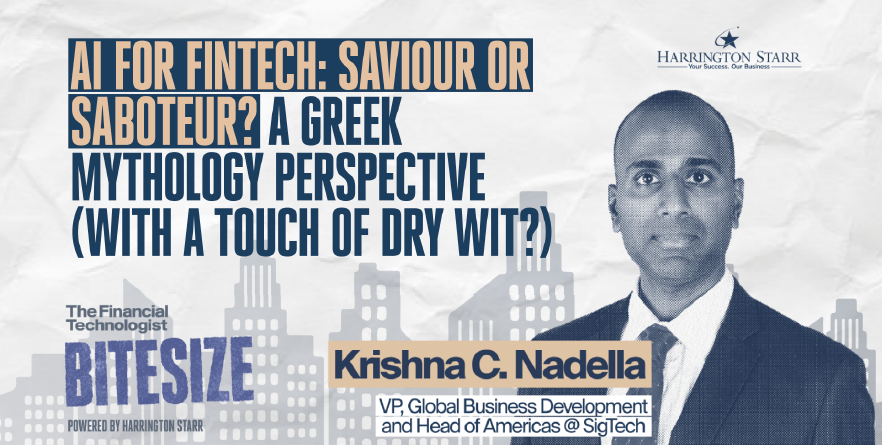
Download your free copy of the latest Financial Technologist magazine here.
To paraphrase Fun Boy Three in their 80s hit (and the 1939 original with Ella Fitzgerald), “It’s not what you do it’s the way that you do it...that's what gets results”.
In my time working in financial services businesses, I’ve always considered it to be a fairly even split between the ‘what’ and the ‘how’ concerning product/service differentiation, client retention and, ultimately, commercial success: The ‘what’ being the service or solution and associated key features and functionality, the ‘how’ being what makes it stand out from the competition concerning reputation, client engagement, user experience, time to market and service delivery.
In the last decade or so, with continuing and industry-changing technological advancement, it seems as if that balance has shifted to place much greater emphasis on the ‘how’; how to stand out from the crowd, how to scale a business appropriately how to optimise go-to-market strategies, how to gain more clients while keeping client churn low, how to invest for continuing success. Technology evolution continues to deliver opportunities to reduce and remove traditional barriers to entry with respect to accessing particular target markets, and the typical challenges associated with launching new products successfully. To illustrate this assertion:
Advent of The Cloud
The advent of cloud computing has not only delivered almost unlimited scalability with respect to effective data storage and management. It can also remove the burden of high capital expenditure and ongoing costly investment in building, deploying and maintaining physical infrastructure and software ‘inhouse’.
Open-Source Software
Increased availability of open-source software and ‘software as a service’ solutions enables the acceleration of development and lead times for technology-led solutions. This, coupled with more agile delivery methodologies, has significantly shortened Proof of Concept/Minimum Viable Product timelines, and this has been further accelerated by the growth in low-code/no-code platforms and services.
Delivery “as a Service”
Continuing demand for and adoption of ‘managed’ services, initially Software as a Service (SaaS) but increasingly embracing the broader and deeper spectrum of service delivery including Infrastructure as a Service and Network as a Service, through to ‘Trading as a Service’ - or outsourced trading - offered by a number of major firms such as TD Cowen. What all ‘as a Service’ models have in common is that they reduce high upfront ‘set up’ costs and rigid, often long-term, (high) fixed price contracts with much more nimble and flexible subscription models. Often consumption-linked, you pay only for what you use, as you use it.
Low code/No code solutions
Ongoing development and adoption of low-code APIs and no-code platforms, along with expectation and demand for greater system/platform interoperability, makes it much easier in today’s world to switch service providers. The time for software vendor complacency based on the cost and difficulty of making a different decision are long gone. Customers today can very much “vote with their feet” when confronted with poor service delivery, whether in terms of inflexible contracts, product performance or customer service.
The fact is that poor response times and slow delivery will inevitably result in higher churn and negative Net Dollar Retention (NDR).
From a service provider perspective, the positive side of all of this technological advance is that it is quicker and easier to gain traction and to grow incrementally. However, another factor impacting the ‘how’ of commercial success in financial services has been the recent change in the availability of ‘cheap money’ that has until relatively recently also been a driver in the influx of new start-ups and FinTechs.
The most significant impact of this change is that user/customer acquisition and growth is no longer enough in and of itself; the old school “win customers first, monetise later” approach has to be increasingly combined with a strategy that prioritises scalable, profitable growth from the outset.
We are also, I believe, entering a new – and significant – disruption phase in the form of AI that will likely place even more emphasis on the ‘how’ with respect to further reducing barriers to entry, particularly on the ‘go-to-market’ side of things. Here, it has the potential to accelerate a firm’s ability to establish a presence through clever and timely multi-channel marketing and communications strategies designed for specific target markets.
The ‘how’ of AI adoption is, however, critical; as with any other ‘innovation’ referenced here, it is a potentially very valuable tool in the business development toolkit. On the one hand, its use needs to be considered within the context of the broader business strategy and goals; on the other, it requires appropriate expertise in its use with respect to content curation and distribution. You might think of it as a sandwich, with AI as the filling that can facilitate and accelerate certain business activities to provide more scale, reduce lead times and increase optionality.
There is little doubt that the industry has become a lot noisier and standing out from the competition is a lot harder. We feel strongly that AI, used correctly, can be a key component of much more dynamic, multi- channel marketing and communications strategies that also fuel more dynamic, data- driven MI and much more accurate insights into customer behaviours and user experiences. This is, in effect, the fusion of AI with business and go-to-market teams. Used incorrectly, for example simply to create “me-too” content without context, or to generate data without actionable insights, and you could end up lost in the crowd.
Download your free copy of the latest Financial Technologist magazine here.





